Lá Fhéile Pádraig – Happy St Patrick’s Day
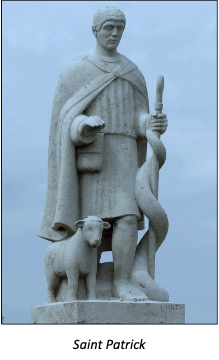
St Patrick, Octagon Monument, Westport, Mayo
The Monument: A change on the skyline
St. Patrick’s Day, 17th March 1990 was not merely the day to honour our Patron Saint, it was also a historic day and a huge achievement in Westport. It was a day which saw a major change on the skyline. A sculpture of St. Patrick on the Monument was blessed by the retired Archbishop Cunnane representing Archbishop Joseph Cassidy who was unavoidably absent due to a bout of ill-health.

John Coffey and Ken Thompson
Sculpture in Portland Stone
An eight-foot-high sculpture in Portland stone of our Patron Saint dominated this significant setting on the Octagon. Ken Thompson, a native of Cork, had lavished all his creativity and artistic talents on an imaginative portrayal of our National Patron. It is the first depiction of him which was true to Patrick’s own words. It caused a huge amount of comment and debate in that it was not the usual presentation of Patrick.
This sculpture presents a youthful energetic young man very much alive and it carries a very rich symbolism. Patrick’s stature with his forward leaning head and broad shoulders depict a man of energy on a journey with a purpose. His features are strong and firm and his huge rugged size carries a gentleness and compassion with his hand outstretched with a blessing. It continues to arouse the curiosity and stimulate the imagination of so many people who visit Westport and walk around the Octagon.
The Monument is adorned with panels depicting writings from St Patrick.
First Panel – The Arrival The Invitation of the Irish People
The first carved panel shows Patrick and his companions arriving in Ireland to offer the Sacraments and Word of God. They are blessed by the hand of God the Father. The Holy Spirit as a dove inspires them. The fish symbolises Christ and completes the Trinity. It also represents the people to be won for Christ. This panel, like the others, is full of rich symbols. The little boy with the net is a future missionary. The boat represents the Bark of Peter, the Church. The mast forms a cross while the anchor is one of most ancient symbols of our Saviour. The foliage is a reference to his dream in which he hears the voice of the Irish people calling him “by the wood of Voclut which is near the western sea.” The inscription “Rogamus te” translates “We invite you.” This panel can also be seen as the departure – representing the whole tradition of the Irish Missionary Church.
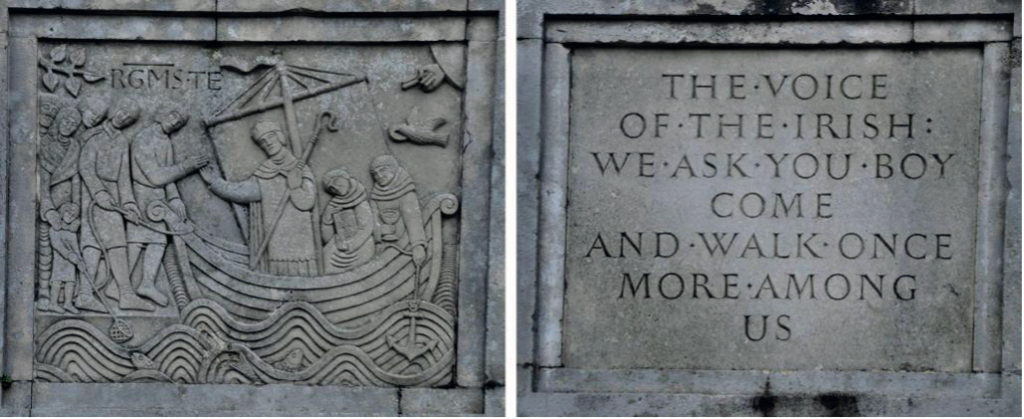
Second Panel – “The Reek” – The Call to be a Missionary Church
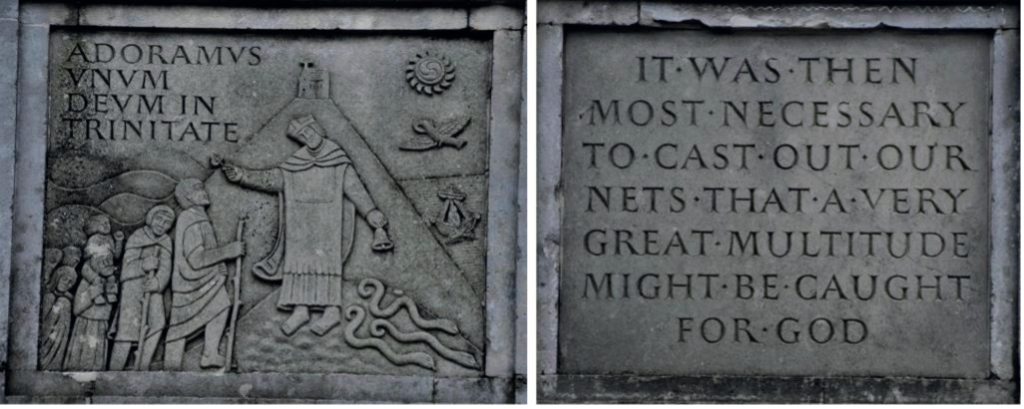
The second carved panel shows Patrick preaching his mission on Croagh Patrick and his work in Ireland. The man fishing, is “casting his net wide.” (third inscription from the Confession). It also alludes to “Thou art Peter and on this rock, I will build my Church.” There is an ancient tradition that when Patrick rang his bell on Croagh Patrick, serpents and scorpions were banished into the sea. He uses the shamrock to explain the truth of the Trinity and the inscription is taken from his own words, “We adore him as one God in the Trinity.” People climbing the Reek with sticks, a familiar sight to the people of Westport and to pilgrims, represents the Irish pilgrimage tradition. This panel also makes reference to the famous hymn “The Breastplate of St. Patrick which was written after his death. “I arise today through the strength of heaven, light of sun, radiance of moon, splendour of fire, speed of lightening, swiftness of wind, death of sea, stability of earth, firmness of rock.”
Third Panel – Baptism The first words of his own Story
The third panel represents a passage in the Confession where Patrick refers to the Baptism by him of a “virtuous Irish lady of noble birth and great beauty” who later became a nun. Her parents hold her robe, representing the new life she receives in Baptism. Her father holds a candle, a symbol of the light of faith. And Patrick’s companion holds up the holy oil for the anointing. All hands and the Flora and Fauna point to the waters of Baptism, while she forms a cross with her arms. The Elk, Wolfhound and Salmon are powerful symbols in Irish mythology. The Elk also is reference to the “deer that yearns for running waters” and alludes to Baptism. The Holy Spirit is present in all four panels, symbolised by a dove. The branches of the tree spring out of the Word of God, and the inscription from the Confession “Venite” translates “Come”.
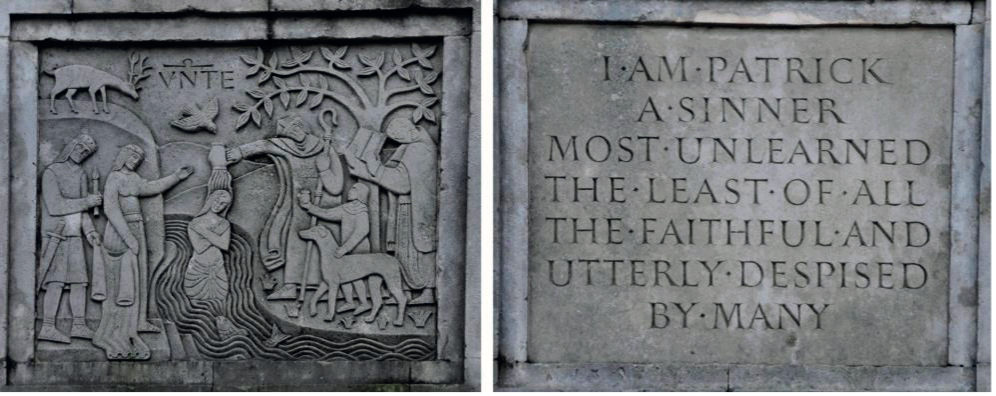
Fourth Panel – Tara – My Mission was the work of God
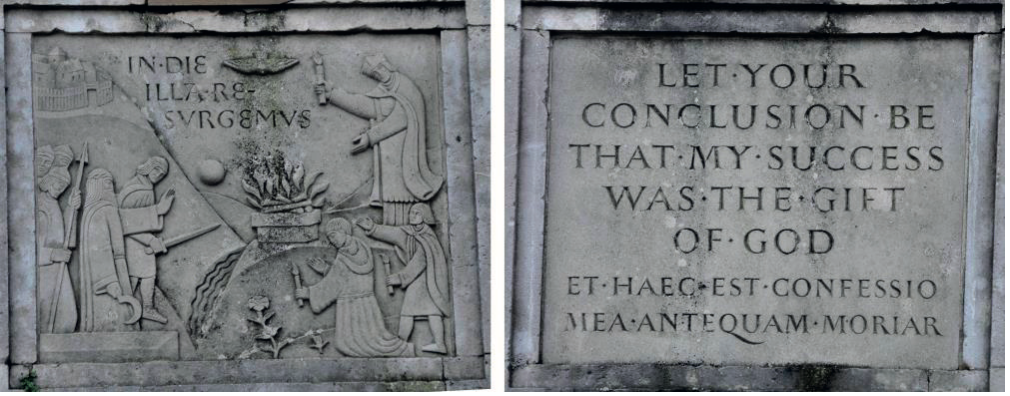
The fourth carved panel in which Patrick confronts the Druids at Tara, celebrates the triumph of the Resurrection. When Patrick comes to Tara at Easter, it happened that the feast fell as the same time as the pagan feast of Fire. Patrick lights the Paschal fire and the Druids prophesy to the King that if this fire is not quenched now the Faith will never be put out in Ireland. Patrick and his companions, holding candles, point to the paschal moon and fire while the Druids and their followers confront them with sickle, sword and spear at the foot of Tara. The inscription is taken from Patrick’s own words, “On the day we will undoubtedly rise (in the brightness of the sun).” The final inscription is taken from the closing words of the Confession and demonstrates, like the first inscription, the humility of Patrick and his desire to give to God the honour, glory and success of his mission. The last two lines are in original Latin in which the Confession is written – “and this is my Confession before I die”.
Our Patron Saint
St. Patrick 385-461. There is an ongoing discussion among scholars on some historical details concerning places and events around the life and work of St. Patrick. But there is no debate about the authenticity of his life story – The Confession and the Letter to Coroticus. They give a very profound insight into his character, personality, faith, trials and commitment to his mission.
Born in Wales in 385, his father was Calpurnius, a deacon in the local Christian community and a Roman official. He was kidnapped by pirates from Ireland in 401. He managed to escape around 408. He was ordained a priest in 424 and later before being sent to Ireland by Pope Celestine by was made a bishop in 432. He spent Lent 441 on Croagh Patrick. He died in 461 in Saul, Co. Down and is buried in Downpatrick.
The late Dr. John Healy, Archbishop of Tuam, 1903-1918, wrote in his history of Croagh Patrick:
When the skies are clear and the soaring cone can be seen in its own solitary grandeur, no eye will turn to gaze upon it without delight. Even when the rain clouds shroud its brow, we know that it is still there and that when the storms have swept over it, it will reveal itself once more in all its calm beauty and majestic strength. It is, therefore, the fitting type of Ireland’s faith and of all Ireland’s nationhood, which nothing has ever shaken and with God’s blessing, nothing can ever destroy.
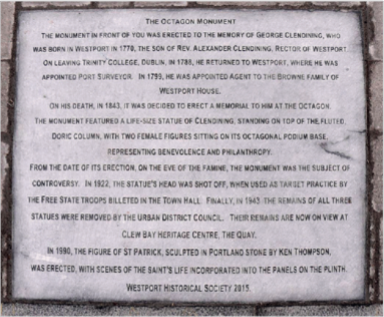
Octagon Monument Plaque
Taken from a book, Dean Bernard Burke, by Rev Anthony King, published CPR 2021.
Anthony (Tony) King born in Cleggan, native of the parish of Clifden (Omey and Ballindoon), Co. Galway. Educated in Cleggan N.S.; St. Jarlath’s College Tuam; St. Patrick’s College, Maynooth. Ordained in 1963. St. Jarlath’s 1963-70, Westport 1970-80 C.C., Adm.1980- 93; Athenry P.P., 1993-2013; Westport P.E. 2013.
